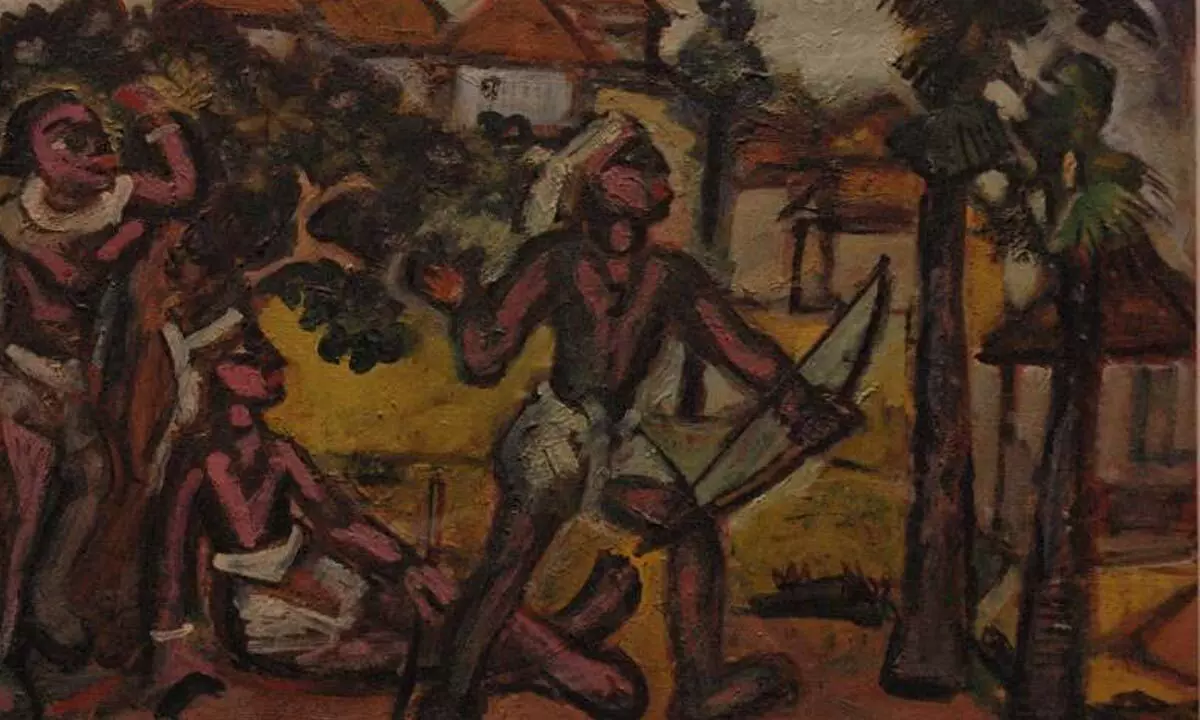Live
- No permission needed for buildings up to 15 metres
- Do you support caste census? Which one will you prefer caste census or skill census?
- GHMC Commissioner attends Prajavani, receives 126 applications
- 6 injured as lift crashes in Bahadurpura apartment
- CM Revanth: Delhi visits are in TG’s interests, scotches buzz on cabinet expansion
- Chandrababu Naidu Wishes People on Constitution Day
- World Heritage Week celebrations conclude
- Coronation of Vishvaraj as Mewar’s 77th successor starts amid questions over palace visit
- Give utmost priority to research: SKLTHU V-C
- IT Min launches ‘Transforming 10,000 Minds’ prog
Just In
Inspiring the Young Generation: The Life and Art of Benode Behari Mukherjee


Art historian and curator R. Siva Kumar offers a profound introduction to the exceptional artist Benode Behari Mukherjee in Satyajit Ray’s documentary film, Inner Eye.
Art historian and curator R. Siva Kumar offers a profound introduction to the exceptional artist Benode Behari Mukherjee in Satyajit Ray’s documentary film, Inner Eye. Satyajit Ray, a celebrated filmmaker and former student of Mukherjee at Shantiniketan, shares a unique perspective on his teacher’s life and work.
Benode Behari Mukherjee was an exceptionally reclusive artist. Thoughtful and non-flamboyant, Mukherjee’s commitment to landscape painting and his innovative approach to depicting nature set him apart. Unlike many of his contemporaries in the Bengal School of Art, who focused on mythological and historical themes, Mukherjee painted the world he observed in his daily life. His works were grounded in reality, offering unembellished depictions of the natural world around him.
Growing up in rural Bengal, where his brother practiced medicine, Mukherjee’s early life was deeply influenced by nature. Despite being blind in one eye and extremely myopic in the other, he spent his childhood exploring the rural landscape, which became his constant companion and central subject in his art.
Mukherjee’s journey took a pivotal turn when he was sent to Shantiniketan at the age of 13 due to its informal education system. There, Rabindranath Tagore founded an art college, which Mukherjee joined, channeling his sense of solitude and deep understanding of nature into his work. This period culminated in a monumental mural on the ceiling of the Shantiniketan hostel in 1940, a sprawling, immersive landscape that left a lasting impression on the young Satyajit Ray.
Ray vividly recalled his first encounter with Mukherjee’s mural, describing it as a scene of rural life teeming with trees, meadows, lakes, people, birds, and animals. This initial impression forged a bond between the artist and the future filmmaker, marking the beginning of a profound influence on Ray’s artistic vision.
Mukherjee’s most significant work came during a period of intense national change. In 1946-47, as India approached independence, he created an 80-foot mural depicting the lives of medieval saints. This complex work reflected the heterodoxy and multiplicity of views that scholars and leaders like Tagore admired in medieval history.
Despite losing his vision completely in 1957 following a failed eye operation, Mukherjee continued to create art and write prolifically. His resilience and innovative spirit, even in the face of blindness, serve as a powerful inspiration. Satyajit Ray’s Inner Eye captures this indomitable spirit, highlighting Mukherjee’s unwavering dedication to his craft and his unique perspective on life.
Mukherjee’s story is a testament to the power of perseverance and creativity. His ability to see and portray the beauty in the world around him, despite his physical limitations, inspires the young generation to look beyond challenges and embrace their passions with determination and originality.
The documentary of Satyajit Ray has a visual of the sketch done by BB Mukherjee when he had zero vision during his last days. His work during the time working on murals are impressive.
Mukherjee’s work on portraits has a special genre of understanding the personality. He was the first artist during the time to paint a civil structure, bridge connecting two communities. The colors used were all natural, his works were connecting to the local traditions and reflected his teacher’s principles.
The young generation and parents can connect with the life of Mukherjee. Parents should realize that natural learning facilitates a wider and holistic development of personality. Every child is especially abled and creates wonders when the natural ambience is given.
And the younger generation can have inspiration from his life. Though physical and emotional challenges, Mukherjee has succeeded in leading an ideal life by contributing to society with a greater message through his life and work.

© 2024 Hyderabad Media House Limited/The Hans India. All rights reserved. Powered by hocalwire.com






